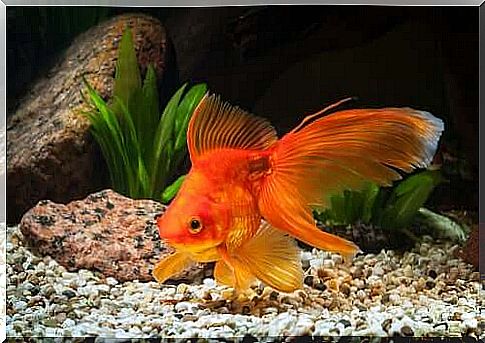The Resilient Health Of The Goldfish: Could The Water Quality Be The Secret?

The goldfish is one of the most popular fish among aquarium owners. It is a fish from the carp family, also called Cyprinidae . You can often see goldfish in aquariums or large ponds in city parks, where they have more space and can get really big. One of the reasons for its popularity is the goldfish’s robust health.
Because of its ability to reproduce, its adaptability to different climatic conditions and its resistance to various diseases, this fish is easy to breed. It originally comes from East Asia and has been known as an ornamental fish in Europe for centuries.
What are the characteristics of a goldfish?
Common goldfish are six to 30 centimeters long and weigh around 300 grams, but in a natural habitat they can grow three times as large and weigh up to two kilograms. Its body is short and oval with long fins and a tail. Therefore the goldfish is a very good swimmer.
These little carp usually come in a variety of yellows and oranges. These are strong and bright colors that also say a lot about the health of the goldfish .
They are also long-lived fish. If you keep them appropriately, they can live between five and ten years. In a natural setting, such as a lake or a pond, there have been specimens that were more than a decade old.

The robust health of the goldfish
The goldfish is a freshwater fish that is not found in seas or oceans. In nature, it prefers the shallow waters of lagoons and slow-flowing rivers, where there is a lot of vegetation and soft subsoil. They are often found near the banks.
But this species is able to survive even under poor conditions, for example in contaminated waters with little oxygen and low temperatures. Not all fish species could survive under such circumstances.
The robust health of the goldfish: it survives in low oxygen levels
Goldfish and other fish species can survive hours or days of anoxia (lack of oxygen). These animals have biological mechanisms to reduce their energy requirements in poor conditions.
This process is called metabolic depression. The physical metabolism of the fish is reduced as much as possible. That’s why he then needs a lot less energy to stay alive. The animal shows a number of physiological changes during metabolic depression:
- The heat production is reduced to a third.
- The fish increases the glycogen reserves in the liver and brain as an energy-producing molecule.
- It does not collect toxic waste products, as the lactic acid in the muscles is converted into ethanol and CO2, which enter the water through the gills.
- Anaerobic glycolysis as a metabolic routine for energy production.

The health of the goldfish at very low temperatures
This species of carp can also endure very low temperatures and, thanks to a number of physiological mechanisms and their behavior, is able to survive even in icy waters during winter.
When it gets colder, the goldfish usually digs their way into the mud and survives for a while. Although he is less active, he still has enough brain activity to stay alert in his natural environment.
Thanks to its special metabolism, its great adaptability to its environment, easy reproduction and longevity, the goldfish has spread all over the world.
It often happens that the keepers release their goldfish in lakes, where it can grow and reproduce without spatial limitation. Since the goldfish does not require any special water quality, it has become a very typical species in our environment.








